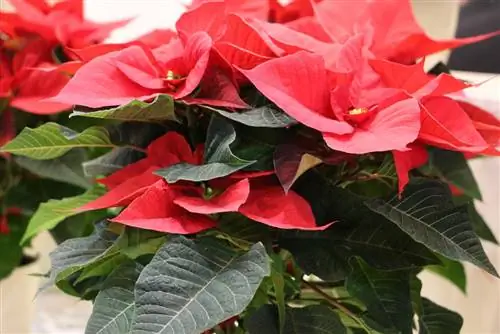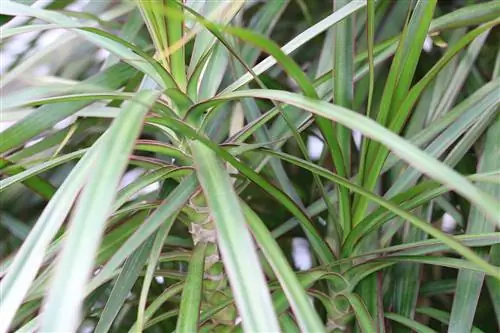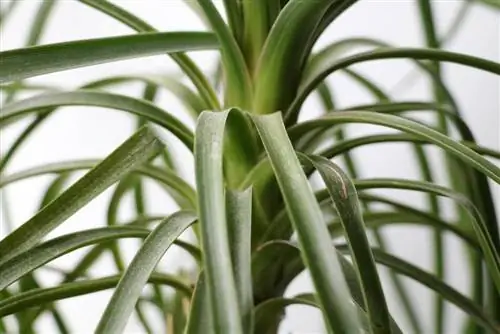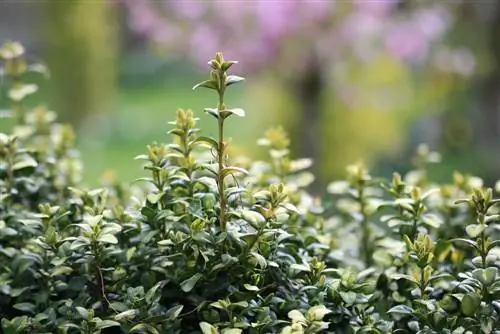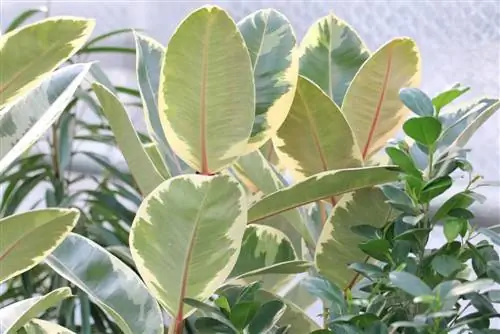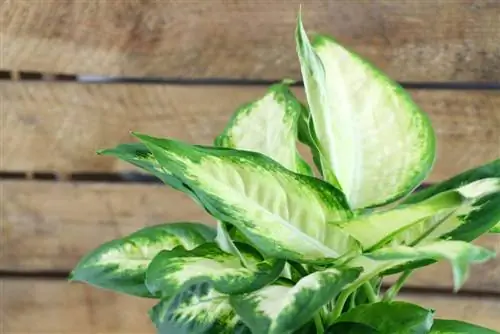- Author admin [email protected].
- Public 2023-12-17 03:39.
- Last modified 2025-01-24 12:45.
The poinsettia (Euphorbia pulcherrima) comes from the spurge family (Euphorbiaceae). In its homeland, in tropical deciduous forests around the world, it often grows as an impressive shrub up to four meters high. All over 2000 species of the spurge family have a whitish, caustic sap in their vessels, the so-called spurge. The poinsettia repeatedly appears in lists of poisonous houseplants. What's the truth about the warnings for people and pets regarding the toxicity of our popular Christmas stars?
Toxicity
The information centers of the poison control centers in Germany classify the toxicity of the poinsettia as “lowly toxic”. A so-called critical dose is “not known”. Nevertheless, the milky juice can cause irritation to the mucous membranes and skin when touched. Consuming it may cause stomach pain and nausea. The reputation for toxicity clearly comes from the wild form, which actually contains large amounts of secondary plant substances in all parts of the plant. These can have negative effects on the organisms of humans and animals. To date, no toxic substances have been detected in the Christmas stars cultivated today. There were experiments with mice and rats that showed no further abnormalities after consumption. Nevertheless, it is worth taking a differentiated look at the possible effects. Especially with small children and pets. As a first aid if the plant parts are consumed, we recommend rinsing your mouth immediately. If you feel sick or have stomach pain, do not force vomiting! It may be necessary to give charcoal tablets. These bind the poison in the intestines. If skin comes into contact with the plant sap, the poison centers recommend washing the affected areas thoroughly.
Substances
Which substance causes these, sometimes more sometimes less harmless, irritations of the skin and digestive system? The milky sap that escapes when the plant is injured serves as protection against feeding and to close wounds. It comes out when the tissue is injured and clots in a few minutes when exposed to air. In the case of the Christmas star these are mainly diterpenes. This is a substance from the group of terpenes, a type of secondary plant substance that protects the plant. Among rainforest peoples, this sap has also played a role in the treatment of certain diseases. Today it is no longer used in medicine because tests over a long period of time have shown that it has carcinogenic properties. During studies, however, this highly irritating substance was only found in the wild form of Euphorbia pulcherrima. Nevertheless, a certain degree of caution seems appropriate when dealing with the poinsettia.
People
Is the poinsettia poisonous to humans? The cultivated form does not contain any of the toxic substances typical of spurge plants. However, all parts of the poinsettia are not suitable for consumption. Sensitive people and small children may experience poisoning-like reactions. Both when consumed and when in contact with the skin and mucous membranes. If severe reactions occur, especially in children, a doctor or a poison control center must be consulted immediately. Since small children usually want to explore everything with their mouths, special care is required when it comes to houseplants. The poinsettia does not have to be taboo; it is sufficient to place it out of the reach of children.
Tip:
If some plant sap gets into your eyes through direct contact with your hands, rinse the eye under running water for at least ten minutes. If there is no improvement, a doctor must be consulted.
Dogs and cats
Animals often react more strongly to poisons and irritants than we humans. First of all, the risk of dogs or cats loving to nibble on poinsettias can be classified as very low. If symptoms of poisoning were caused by the poinsettia at all, then the animal must have consumed large amounts of the plant over a long period of time. It is relatively unlikely that the owner will not notice this early enough. When it comes to cats, there are quite a few panic reports about poinsettia poisoning on the Internet. As mentioned, the irritating substances (diterpenes) no longer occur in our cultivated Christmas stars. Acute and severe symptoms of poisoning in dogs, as in cats, are therefore rather unlikely. Most people nibble on a leaf out of boredom. The body's own defense system usually copes well with this stimulus. Caution is advised with young animals and larger quantities consumed. If unusual behavior occurs up to two hours after consumption (increased salivation, vomiting, staggering, etc.), a veterinarian should be consulted immediately. If you want to be on the safe side, you should generally avoid having poisonous or mildly poisonous houseplants in your house. Especially if a cat or dog is left unattended or kept mostly indoors for a long time.
Small animals and birds
The smaller the organism, the smaller doses of mildly toxic substances are sufficient to cause strong reactions, including death. It is therefore advisable to be even more careful with rabbits, hamsters, guinea pigs and birds. Even if the really irritating substances in the juices of the cultivated poinsettias have not been detected. It really is better to be safe than sorry here. Harmful effects after contact or consumption of plant parts of the Christmas star also affect small animals
- the gastrointestinal tract
- all mucous membranes
- the skin
Attention:
For very small animals, consumption can even lead to death.
Important information
The toxic substances present in the wild form have not yet been detected in the cultivated forms. Nevertheless, one must assume that not all of the cultural forms that are now commercially available have been examined for this purpose. The symptoms of poisoning due to irritation of the gastrointestinal tract or the (mucous) skin are noticeable as follows:
- Nausea
- Stomach cramps
- Vomiting
- increased salivation
- bloody stool, urine
- drop in body temperature
- Symptoms of paralysis
- balance disorders
- Skin redness
- Skin burning
If you have suspicions, there is no time to waste. First self-help measures are to drink a lot and, if symptoms are severe, take charcoal tablets. These remove the poison from the body within three to four hours. Superficial irritations are rinsed with plenty of water.
Conclusion
Despite many studies and research into the toxicity of the substances in poinsettias, ultimately there will be no green light in terms of their harmlessness and safety for humans and animals. If in doubt, it is better to avoid the Christmas decorations of the Euphorbia pulcherrima. At the slightest sign of poisoning in a child or pet, a doctor should be consulted immediately.

